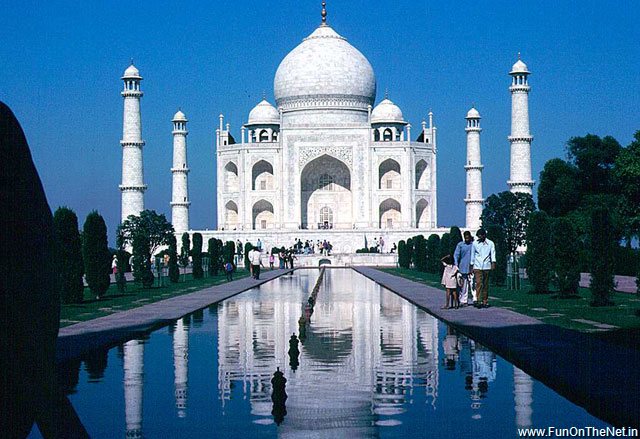 Welcome to Agra on your tour package to Taj Mahal-The symbol of love. Uttar Pradesh is the heartland of Hinduism and Hindi, dominating the nation in culture, religion, language and politics. The magic of the monument is strangely undiminished by the crowd of tourists who visit during their Taj Mahal package tour, as small and insignificant as ants in the face of the immense mausoleum.
Welcome to Agra on your tour package to Taj Mahal-The symbol of love. Uttar Pradesh is the heartland of Hinduism and Hindi, dominating the nation in culture, religion, language and politics. The magic of the monument is strangely undiminished by the crowd of tourists who visit during their Taj Mahal package tour, as small and insignificant as ants in the face of the immense mausoleum.Welcome to Agra on your tour package to Taj Mahal-The symbol of love. Uttar Pradesh is the heartland of Hinduism and Hindi, dominating the nation in culture, religion, language and politics. Western UP has always been close to India's centre of power. Its main city, Agra, once the Mughal capital, is home to the Taj Mahal ? The symbol of love. Along with Delhi, 204km northwest, and Jaipur in Rajasthan, Agra is the third apex of the Golden Triangle, India's most popular itinerary for Taj Mahal visit. Taj Mahal is the most famous and prominent of its stupendous monuments. Described by Bengali poet Rabindranath Tagore as "a teardrop on the face of eternity", the Taj Mahal is undoubtedly the zenith of Mughal architecture. Volumes have been written on its perfection, and its image adorns countless glossy brochures and guidebooks; nonetheless, the reality never fails to overwhelm all who see it, and few words can do it justice.
During your Taj Mahal visit you will see that though its layout follows a distinctly Islamic theme, representing Paradise, it is above all monument to romantic love. Taj Mahal is regarded by most modern visitors on his/her tour to Taj Mahal as the symbol of eternal love. ShahJahan built the Taj to enshrine the body of his beloved wife, Mumtaz Mahal, who died shortly after giving birth to her fourteenth child in 1631. The emperor was devastated by her death, and set out to create an unsurpassed monument to her memory- Its name, "Taj Mahal "is simply a shortened, informal version of Mumtaz Mahal's palace title. Construction by a workforce of some 20,000 men from all over Asia commenced in 1632 and took over twenty years, not being completed until 1653. Marble was brought from Makrana , near Ajmer in Rajasthan, and semi-precious stones for decoration were carried to Agra from Persia, Russia, Afghanistan, Tibet, China and the Indian ocean. When the emperor ShahJahan died in January 1666, his body was carried across the river Yamuna to lie alongside his beloved wife in his peerless tomb.
The magic of the monument is strangely undiminished by the crowd of tourists who visit during their Taj Mahal package tour, as small and insignificant as ants in the face of the immense mausoleum. It is said that the Taj Mahal is at its most alluring in the relative quiet of early morning, shrouded in mist and bathed with a soft red glow. As its vast marble surfaces fall into shadow or reflect the sun, its colour changes, from soft grey and yellow to pearly cream and dazzling white. This play of light is an important decorative device, symbolically implying the presence of Allah, who is never represented in physical form. The Taj is particularly beautiful after dark, when the moonlight sparkles on the façade; it is open to visitors except its normal visiting time, in two half hour slots ( 8.30 ? 9 pm and 9 ? 9.30 pm, but not Fridays or during Ramjan ) on the night of the full moon, two days preceding and two days following it. Tickets have to be purchased a day in advance for it. Night visitors are not allowed to move freely around the site but are confined to a viewing platform.
The Taj Mahal (also “The Taj”) is considered the finest example of Mughal architecture, a style that combines elements from Persian, Indian, and Islamic architectural styles. In 1983, the Taj Mahal became a UNESCO World Heritage Site and was cited as “the jewel of Muslim art in India and one of the universally admired masterpieces of the world’s heritage.”
While the white domed marble mausoleum is its most familiar component, the Taj Mahal is actually an integrated complex of structures. Building began around 1632 and was completed around 1653, and employed thousands of artisans and craftsmen. The construction of the Taj Mahal was entrusted to a board of architects under imperial supervision including Abd ul-Karim Ma’mur Khan, Makramat Khan, and Ustad Ahmad Lahauri. Lahauri is generally considered to be the principal designer.


